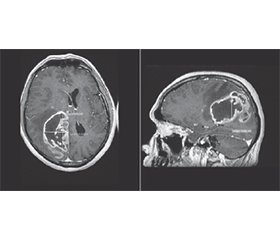Резюме
Гліобластома, що характеризується агресивним перебігом і поганим прогнозом, залишається складною проблемою нейроонкології. Стандартні методи лікування, включно з максимально безпечною хірургічною резекцію, подальшою ад’ювантною хіміотерапією та променевою терапією, спрямовані на продовження життя й полегшення симптомів. Однак, незважаючи на ці втручання, прогноз залишається несприятливим, особливо за субтотальної резекції. У цьому клінічному випадку розглядається вплив субтотальної резекції на виживаність пацієнтів із гліобластомою. 46-річний чоловік звернувся зі скаргами на головний біль і слабкість лівої сторони тіла, що потребувало госпіталізації та подальшого хірургічного втручання. Проведено субтотальну резекцію з видаленням приблизно 95 % пухлини. Після операції пацієнт отримував хіміотерапію темозоломідом (75 мг/м2) протягом шести тижнів, але від променевої терапії відмовився. Примітно, що після лікування чоловік відчув полегшення симптомів і прожив шість місяців. Цей клінічний випадок підкреслює потенціал субтотальної резекції в лікуванні гліобластоми, особливо у випадках, коли повне видалення пухлини неможливо. Також наголошується на важливості індивідуального підходу до лікування й необхідності подальших досліджень для оптимізації результатів у пацієнтів із гліобластомою, які мають менш сприятливий прогноз.
Glioblastoma characterized by aggressive nature and poor prognosis remains a challenging entity in neuro-oncology. Standard treatment modalities, including maximal safe surgical resection followed by adjuvant chemotherapy and radiotherapy, aim to prolong survival and alleviate symptoms. However, despite these interventions, prognosis remains dismal, particularly in cases of subtotal resection. This case study delves into the effect of subtotal resection on survival outcomes in glioblastoma patients. A 46-year-old male presented with symptoms of headache and left-sided weakness, prompting admission and subsequent surgical intervention. Subtotal resection, achieving approximately 95 % tumor removal, was performed. Following surgery, the patient underwent chemotherapy with temozolomide (75 mg/m2) for six weeks, omitting radiotherapy. Remarkably, the patient experienced symptom alleviation post-treatment and survived for six months. This case highlights the potential of subtotal resection in managing glioblastoma, particularly in cases where complete excision is not feasible. Additionally, it underscores the need for individualized treatment approaches and further research to optimize outcomes in glioblastoma patients with less favorable prognoses.
Список литературы
1. Omuro A, DeAngelis LM. Glioblastoma and other malignant gliomas: a clinical review. JAMA. 2013;310:1842-1850.
2. Bryukhovetskii IS, Bryukhovetskii AS, Khotimchenko YS. New biomolecular approaches to the treatment of glioblastoma multiforme. Bull Exp Biol Med.2015;158:794-799.
3. Chaulagain D, Smolanka V, Smolanka A, Havryliv T. Glioblastoma: a literature review. International Neurological Journal. 2023;18(8):32-37. doi: 10.22141/2224-0713.18.8.2022.987.
4. Sanai N, Berger MS. Glioma extent of resection and its impact on patient outcome. Neurosurgery. 2008;62:753-764; discussion 264-266.
5. Sanai N, Polley MY, McDermott MW, Parsa AT, Berger MS. An extent of resection threshold for newly diagnosed glioblastomas. J Neurosurg. 2011;115:3-8.
6. Chaulagain D, Smolanka V, Smolanka A, Munakomi S. The Impact of Extent of Resection on the Prognosis of Glioblastoma Multiforme: A Systematic Review and Meta-analysis. Open Access Maced J Med Sci. 2022 May 26;10(F):345-354. doi: 10.3889/oamjms.2022.8970.
7. Chaulagain D, Smolanka V, Smolanka A, Havryliv T. Advancements in surgical management of glioblastoma: current trends and promising future directions. International Neurological Journal. 2023;19(5):155-159. doi: 10.22141/2224-0713.19.5.2023.1015.
8. Kessler AF, Linsenmann T, Westermaier T, et al. Complete radiological response following subtotal resection in three glioblastoma patients under treatment with Tumor Treating Fields. Oncol Lett. 2020;19(1):557-561. doi: 10.3892/ol.2019.11110.
9. Aguilera DG, Tomita T, Rajaram V, et al. Glioblastoma multiforme in a patient with chronic granulomatous disease treated with subtotal resection, radiation, and thalidomide: case report of a long-term survivor. J Pediatr Hematol Oncol. 2009;31:965-9. doi: 10.1097/MPH.0b013e3181b84751.
10. Nishio S, Morioka T, Suzuki S, et al. Thalamic gliomas: a clinicopathologic analysis of 20 cases with reference to patient age. Acta Neurochir (Wien). 1997;139:336-42.
11. Marko NF, Weil RJ, Schroeder JL, Lang FF, Suki D, Sawaya RE. Extent of resection of glioblastoma revisited: personalized survival modeling facilitates more accurate survival prediction and supports a maximum-safe-resection approach to surgery. J Clin Oncol. 2014;32:774-782.
12. Molinaro AM, Hervey-Jumper S, Morshed RA, et al. Association of maximal extent of resection of contrast-enhanced and non-contrast-enhanced tumor with survival within molecular subgroups of patients with newly diagnosed glioblastoma. JAMA Oncol. 2020;6:495-503.
13. Chaichana KL, Jusue-Torres I, Navarro-Ramirez R, et al. Establishing percent resection and residual volume thresholds affecting survival and recurrence for patients with newly diagnosed intracranial glioblastoma. Neuro Oncol. 2014;16:113-122.
14. Laws ER, Parney IF, Huang W, et al. Survival following surgery and prognostic factors for recently diagnosed malignant glioma: data from the Glioma Outcomes Project. Journal of Neurosurgery. 2003;99(3):467-473. doi: 10.3171/jns.2003.99.3.0467.
15. McGirt MJ, Chaichana KL, Gathinji M, et al. Independent association of extent of resection with survival in patients with malignant brain astrocytoma. Journal of Neurosurgery. 2009;110(1):156-162. doi: 10.3171/2008.4.17536.
16. Di Russo P, Perrini P, Pasqualetti F, et al. Management and outcome of high-grade multicentric gliomas: a contemporary single-institution series and review of the literature. Acta Neurochir. 2013;155:2245-2251. doi: 10.1007/s00701-013-1892-9.
17. Sanai N, Polley M, Berger MS. Insular glioma resection: assessment of patient morbidity, survival, and tumor progression. Journal of Neurosurgery. 2010;112(1):1-9. doi: 10.3171/2009.6.JNS0952.
18. Wang Y, Li S, Zhang Z, Chen X, You G, et al. Surgical extent impacts the value of the established prognosticators in glioblastoma patients: A prospective translational study in Asia. Head Neck Oncol. 2012;4:80.
19. Bloch O, Han SJ, Cha S, Sun MZ, Aghi MK, et al. Impact of extent of resection for recurrent glioblastoma on overall survival clinical article. J Neurosurg. 2012;117:1032-1038. doi: 10.3171/2012.9.JNS12504.

